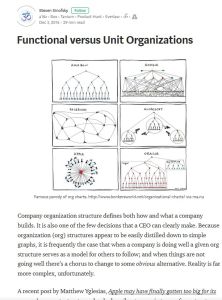
Steven Sinofsky
Functional Versus Unit Organizations
Medium, 2016
What's inside?
How you choose to organize your company matters – both for your employees and your products.
Recommendation
“Functional” or “unit” organization – which one is best for your business? In this detailed and pragmatic article, Steven Sinofsky, former president of Microsoft’s Windows division, tackles the myths and misconceptions surrounding structural reorganization endeavors. Using his time at Microsoft for exemplification, Sinofsky lays out the strengths and weaknesses of functional and unit organizational structures and lists basic insights about the challenge of reorganization. Although Sinofsky’s post would have benefited from a round of editing, getAbstract recommends this valuable article to managers pondering change.
Take-Aways
- While many people speak of “functional” and “unit” organizational setups in binary terms, few company structures are exclusively function- or unit-based.
- Changes in structure affect the product your company creates and how you utilize human talent.
- Be aware that change will solve some issues while making other aspects of business more difficult.
- A functional structure encourages companywide collaboration and works well when the focus is on one main product. Unit structures work well when a company has many products, since independent teams can concentrate on solving specific problems.
- Regardless of your choice of structure, some elements, such as resource allocation, will remain problematic, and the singular importance of your “ship schedule” won’t diminish.
Summary
The structure of a company not only affects its human talent, but also the products it creates. In theory, CEOs have a choice between a “functional” or “unit” organizational model. However, few companies exemplify either structure exclusively – and for good reason. For instance, even a company with a unit-based structure – which builds its teams around product lines – would probably have a global sales team led by a sales manager rather than a bunch of small teams.
“Purity in organizational (org) structure makes for great caricatures of orgs, but operationally rarely exists.”
The tendency to pit the unit and functional models against one another also means that, in times of crisis, leaders may feel tempted to simply switch to the other model – a move which will most likely bring as many new challenges as it does solutions. Thus, before making any kind of organizational change, CEOs should first identify what problems they aim to solve and take steps to mitigate any new issues a change in structure may create. For Microsoft’s reorganization to a function-based organizational system – structuring teams around a particular kind of expertise – for example, this meant being transparent about how that change affected people’s career prospects and opportunities.
“Every org change I ever saw that didn’t work started off not with a problem statement but with a goal of putting a certain person in charge or a boss-centric perspective of grouping some things together or separating some things.”
A functional structure works well when a company’s focus is on one main product (or suite of products). This model encourages companywide collaboration and fosters “depth of skills” in main knowledge areas rather than broad, managerial skills. However, functional structures can make holding people accountable and managing a remote workforce quite difficult. Unit structures work well when a company creates multiple products in different markets, since teams can concentrate on solving specific product-related problems. In the unit model, accountability is clear, but lack of cooperation with other teams can lead to overlapping activities. Unit structures depend on good general managers, which may deprive a company of the insights discipline-specific leaders can produce.
“There is no general answer to the question of ‘functional or unit’ absent the context of a specific set of people, at a specific company, working on a specific product plan. There are some well-understood pros and cons to each of these org structures.”
Regardless of your choice of structure, certain things will hold true. Resource allocation will always remain an issue; you will get the outcome you “optimize for”; some divisions, such as sales, will never conform to a unit structure; and, most important, aligning all business functions based on one schedule is essential one way or the other.
About the Author
Steven Sinofsky is a board partner at Andreessen Horowitz and former president of Microsoft’s Windows division.
This document is restricted to personal use only.
My Highlights
Did you like this summary?
Read the articleThis summary has been shared with you by getAbstract.
We find, rate and summarize relevant knowledge to help people make better decisions in business and in their private lives.
Already a customer? Log in here.
















Comment on this summary